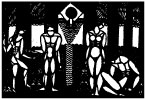| |
Many contemporary scholars argue that both the the plot and use of physical symbol in Neith Boyce’s Winter Night were deeply influential on both Glaspell’s writing of Trifles, which premiered just a few weeks after Winter’s Night, and on O’Neill’s forthcoming Beyond the Horizon, for which he would be awarded his first Pulitzer Prize. Murphy names Winter’s Night not only one of the three best plays of that summer, but one of the best one-acts in the American repertoire, as it epitomizes “the maturing of realist aesthetics in the American theatre during the teens.”(1) Floyd Dell claims the basic plot for the play was taken from a story that George Cram Cook repeated often: that Cook’s second wife, Mollie, was nearly seduced by her brother-in-law at a family wake. Dell also claimed in an interview with Sarlos that both he and Sherwood Anderson used this as the basis for short stories.(2) The cast for the play was Nancy Schoonmaker as Rachel,(3) the widow; Jig Cook as Jacob, her brother-in-law; and Mary Heaton Vorse as Sarah, Rachel’s friend.
The play takes place on a very cold winter night as Rachel returns to her farm home with her brother-in-law, Jacob, after burying her husband. As Rachel tells of her plans to leave and set up a dress-making business in order to have a life more like she desires, Jacob reveals his longtime unspoken love for her. Rachel responds negatively and Jacob gets more impassioned, almost demanding that she return his feelings. When Rachel’s friend Sarah arrives to stay the night, breaking up the intense conversation between the two, Jacob, having been rejected, leaves the house with a shotgun and we hear it fire. Sarah runs out and returns with the news that she found Jacob with “his head all blown to pieces.”(4) The scream that Vorse uttered when Sarah goes to investigate and finds Jacob seems to have been very memorable and caused “quite a stir.”(5) In a September 10, 1916 Boston Sunday Globe article, a response in the audience to this play is recorded by the reporter: “Why, it’s like the Irish Players!”(6)
Boyce set up visual contrasts in the play by having Rachel dressed in black and a widow’s veil (the ultimate symbol of Victorian tradition), but discussing how she loves bright colors, at one point wearing an apron with a bright red bow, and at another sewing a dress of deep purple. The dark winter night is also contrasted with the potted flowers, curtains, white paint, and colorful china. The playwright maturely uses these contrasts to visually reveal the disparity between her marriage of duty and her real self. Murphy writes of how the two main props of the show, her sewing basket and Jacob’s shotgun, “become the poles of the conflict between the characters.”(7) The play is also filled with silences, Murphy likening them to the “quiet realism” of the domestic drama as seen in plays by James A. Herne.(8) Judith Barlow names Winter Night “a naturalistic play with symbolic overtones” and brings attention to the irony of the biblical names Boyce has given her characters: “the biblical Jacob was the husband of Rachel, and Boyce’s Jacob wants to claim his namesake’s privilege.”(9) Barlow also points to a line that was added upon a revision of the play: “Rachel sums up her situation: ‘I’m in prison here. I have been for years,’” and later adds that the character “is less a victim of the two men than of the assumption that marriage is the ideal situation for all women. In this way Boyce’s play is more radical than many of the feminist novels from the period . . . ”(10) It also echoes some of Boyce’s feelings in her own well-documented experience of marriage to Hutchins Hapgood. Glaspell seems to incorporate many similar symbolic devices in her play Trifles, which is set in a similar area of the country and season of the year, and also takes on the theme of women in marriage, though her examination is housed in the structure of a murder investigation. O’Neill’s Beyond the Horizon echoes Boyce’s plot in that it is about two brothers in love with the same woman.
© Jeff Kennedy 2007
(1) Murphy, Provincetown2/31.
(3) Nancy Schoonmaker was politically active, later running for Congress in Connecticut, and was married to Edwin Schoonmaker, who wrote for socialist journals as well as books and verse dramas.
(4) Shay, Fifty More Contemporary One Acts 46.
(6) Boston Sunday Globe, 10 September 1916: 99.
(7) Murphy, Provincetown2/37.
(8) Murphy, Provincetown 2/37.
(9) Barlow, “Susan’s Sisters” in Ben-Zvi, Essays 264.
(10) Barlow, “Susan’s Sisters” in Ben-Zvi, Essays 265.
|
